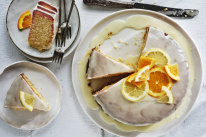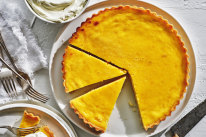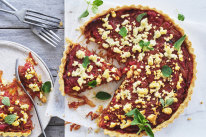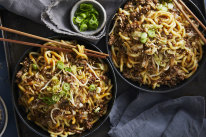Mark the change of season with RecipeTin Eats’ spring fling asparagus quiche
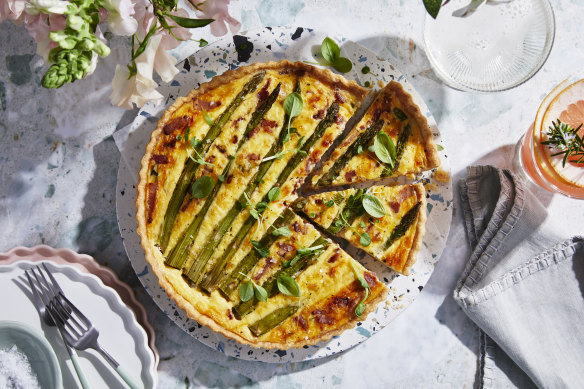
A home-made quiche is a thing of beauty. Making the buttery pastry does take time, but it’s worth every minute. As for the filling, this one is all about spring. Fresh asparagus is mixed into the creamy custard and decorates the surface. And of course, a good scattering of bacon, whatever the season, never hurts.
Ingredients
Shortcrust pastry
185g (1¼ cups) plain flour
½ tsp cooking salt
100g unsalted butter, cold, cubed
2 ½ tbsp ice-cold water (plus more if required)
Asparagus and bacon filling
2 bunches asparagus (about 15 stalks), ends trimmed
200g streaky bacon
15g unsalted butter
½ brown onion, finely chopped
1 garlic clove, finely chopped
3 large eggs
150ml (⅔ cup) full-cream milk
150ml (⅔ cup) thickened cream
pinch of cooking salt and black pepper
100g (1 cup) shredded gruyere (substitute cheddar or colby)
Method
Step 1
To make the shortcrust pastry, pulse the flour, salt and butter in a food processor 10 times or until it looks like breadcrumbs. With the motor running on low, pour the water into the tube feeder, then blitz on high for 30 seconds or until it turns into a ball of dough (see note). Pat the dough into a 2cm thick disc, wrap it in cling wrap and refrigerate for 1 hour.
Step 2
Prepare the asparagus by setting aside 7 whole stalks and chopping the rest into 5mm pieces. Cut 50g of the bacon into 2cm x 1cm pieces and chop the remaining 150g into 1cm dice.
Step 3
Preheat the oven to 180C fan-forced (200C conventional).
Step 4
To make the filling, melt the butter in a non-stick frying pan over medium-high heat. Cook the 2cm bacon pieces until golden then remove to a plate lined with paper towels using a slotted spoon. Set aside. In the same pan, cook the onion, garlic and remaining bacon for 2 minutes, until the onion softens. Add the chopped asparagus and cook for 2 more minutes, stirring. Transfer the mixture to a bowl lined with paper towels and leave to cool.
Step 5
To make the custard mixture, place the eggs, milk and cream in a large bowl and whisk to combine. Season with salt and pepper. Set aside.
Step 6
To cook the pastry case, remove the dough from the fridge and roll into a 27cm round on a lightly floured work surface. Carefully fit it into a 23cm quiche pan without stretching or pulling the pastry (see note). Trim away any overhanging pastry.
Step 7
Prick the base of the pastry lightly 30 times with a fork. Cover with 2 large pieces of baking paper arranged in an X and fill with baking beads, raw chickpeas or dry beans.
Step 8
Bake for 20 minutes, then remove from the oven. Reduce oven temperature to 160C fan-forced (180C conventional) and carefully remove the paper and baking beads using the overhanging paper, then bake the pastry for another 10 minutes until light golden.
Step 9
Remove the pastry case from the oven and turn the oven back up to 180C fan-forced (200C conventional). Place the prepared pastry case and tin on a baking tray.
Step 10
To assemble and bake, scatter the bacon and asparagus filling evenly across the pastry base, then top with cheese. Carefully pour in the custard mixture without dislodging the asparagus and bacon mixture and place the whole asparagus stalks on top. Scatter on the larger pieces of bacon.
Step 11
Bake for 35-40 minutes until the top is light golden. The centre should still be slightly jiggly. Remove from the oven and rest the quiche for 10 minutes before removing from the pan. Cut into wedges and serve.
Notes
- If the dough is not forming a ball in the food processor, add a little extra water, half a tablespoon at a time.
- The trick to minimising crust shrinkage is to avoid stretching the dough when fitting it into the quiche tin. If you stretch it, it will shrink back when cooked. Weighing it down with beads and blind baking also helps.
Appears in these collections
- Here’s a tip – asparagus is cheap and in season. Here are five ways to use it
- 40 fantastique French recipes for the Paris Olympics (and beyond)
- 21 delicious dishes to take when they say ‘bring a plate’
- From a summery pie to stir-fries: The 20 most popular recipes of September
- Five perfect picnic-friendly tarts to bake this weekend
The best recipes from Australia's leading chefs straight to your inbox.
Sign up- More:
- Baking
- Entertaining
- Bacon, ham & prosciutto
- Cheese
- Cream & milk
- Eggs
- Light lunch
- Lunch
- Main course
- Savoury pies & tarts
- Picnic
- Kid-friendly
- Nut-free
- French
- In season
- Asparagus
From our partners
Similar Recipes
More by RecipeTin Eats
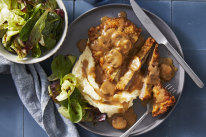
Oh crumbs! RecipeTin’s secret to making cheap but chewy minute steak a juicy, tasty joy
- 30 mins - 1 hr
- RecipeTin Eats
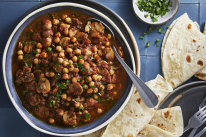
RecipeTin Eats’ one-pot spiced chickpeas and mushrooms is a vegetarian slam-dunk
- 30 mins - 1 hr
- RecipeTin Eats
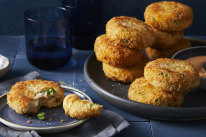
The RecipeTin magic touch that lifts these tuna patties from meh to marvellous
- 30 mins - 1 hr
- RecipeTin Eats

What do you call this, dhal? No, it’s RecipeTin Eats’ lentil chickpea coconut curry
- 30 mins - 1 hr
- RecipeTin Eats


